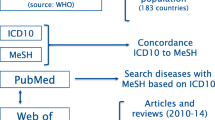Abstract
Despite the importance and magnitude of biomedical research, little is known about its development and responsiveness to current health needs. Herein, we characterized the evolution of disease specific biomedical research and assess the alignment of research and translational efforts with disease burden. Publication patterns for approximately 2700 diseases indicated a fluid landscape of modern biomedical interests. In studying a subset of diseases with available data, overall measures of disease burden explained a large fraction of publication variance but only a small portion of NIH funding variance. In addition, discrete measures of mortality and morbidity differentially impacted NIH funding levels, research efforts, and the number of clinical trials in the US. Our findings not only scrutinize the relevance of our current biomedical enterprise, but may also serve as a resource for fostering strategies that adequately prepare the scientific community to address future health needs and promote accountability in the allocation of resources.




Similar content being viewed by others
Abbreviations
- NIH:
-
National Institute of Health
- MeSH:
-
Medical Subject Heading
- DALY:
-
Disability-adjusted life year
- YLL:
-
Years of life lost
- YLD:
-
Years lived with disability
References
Aoun, S., Pennebaker, D., & Pascal, R. (2004). To what extent is health and medical research funding associated with the burden of disease in Australia? Australian and New Zealand Journal of Public Health, 28(1), 80–86.
Carter, A. J., & Nguyen, C. N. (2012). A comparison of cancer burden and research spending reveals discrepancies in the distribution of research funding. BMC Public Health, 12, 526. doi:10.1186/1471-2458-12-526.
Catalá López, F., Álvarez Martín, E., Gènova Maleras, R., & Morant, Ginestar C. (2009). Relación en España entre la investigación sanitaria financiada por el Sistema Nacional de Salud y la carga de enfermedad en la comunidad. Revista Española de Salud Pública, 83(1), 137–151. doi:10.1590/s1135-57272009000100011.
Colaco, M., Svider, P. F., Mauro, K. M., Eloy, J. A., & Jackson-Rosario, I. (2013). Is there a relationship between National Institutes of Health funding and research impact on academic urology? The Journal of Urology, 190(3), 999–1003. doi:10.1016/j.juro.2013.02.3186.
Ehrhardt, S., Appel, L. J., & Meinert, C. L. (2015). Trends in National Institutes of Health funding for clinical trials registered in ClinicalTrials.gov. JAMA, 314(23), 2566–2567. doi:10.1001/jama.2015.12206.
Gillum, L. A., Gouveia, C., Dorsey, E. R., Pletcher, M., Mathers, C. D., McCulloch, C. E., et al. (2011). NIH disease funding levels and burden of disease. PLoS ONE, 6(2), e16837. doi:10.1371/journal.pone.0016837.
Gross, C. P., Anderson, G. F., & Powe, N. R. (1999). The relation between funding by the National Institutes of Health and the burden of disease. New England Journal of Medicine, 340(24), 1881–1887. doi:10.1056/nejm199906173402406.
He, G., Xu, G., Zhang, Z., Lv, Q., Li, Y., Ye, R., et al. (2014). NSFC health research funding and burden of disease in China. PLoS ONE, 9(11), e111458. doi:10.1371/journal.pone.0111458.
Lamarre-Cliche, M., Castilloux, A. M., & LeLorier, J. (2001). Association between the burden of disease and research funding by the Medical Research Council of Canada and the National Institutes of Health. A cross-sectional study. Clinical and Investigative Medicine, 24(2), 83–89.
Manton, K. G., Gu, X. L., Lowrimore, G., Ullian, A., & Tolley, H. D. (2009). NIH funding trajectories and their correlations with US health dynamics from 1950 to 2004. Proceedings of the National Academy of Sciences, 106(27), 10981–10986. doi:10.1073/pnas.0905104106.
Miranda, J. J., Lyubarova, R., Itagaki, B. K., & Itagaki, M. W. (2009). The impact of National Institutes of Health funding on U.S. cardiovascular disease research. PLoS ONE, 4(7), e6425. doi:10.1371/journal.pone.0006425.
Reardon, S. (2014). Lobbying sways NIH grants. Nature, 515(7525), 19. doi:10.1038/515019a.
Sampat, B. N., Buterbaugh, K., & Perl, M. (2013). New evidence on the allocation of NIH funds across diseases. Milbank Quarterly, 91(1), 163–185. doi:10.1111/milq.12005.
Schilsky, R. L. (2002). End points in cancer clinical trials and the drug approval process. Clinical Cancer Research, 8(4), 935–938.
Slominski, A. T., Karimkhani, C., Boyers, L. N., Margolis, D. J., Naghavi, M., Hay, R. J., et al. (2014). Comparing cutaneous research funded by the National Institute of Arthritis and Musculoskeletal and Skin Diseases with 2010 Global Burden of Disease results. PLoS ONE, 9(7), e102122. doi:10.1371/journal.pone.0102122.
Svider, P. F., Husain, Q., Folbe, A. J., Couldwell, W. T., Liu, J. K., & Eloy, J. A. (2014a). Assessing National Institutes of Health funding and scholarly impact in neurological surgery. Journal of Neurosurgery, 120(1), 191–196. doi:10.3171/2013.8.jns13938.
Svider, P. F., Lopez, S. A., Husain, Q., Bhagat, N., Eloy, J. A., & Langer, P. D. (2014b). The association between scholarly impact and National Institutes of Health funding in ophthalmology. Ophthalmology, 121(1), 423–428. doi:10.1016/j.ophtha.2013.08.009.
Svider, P. F., Mauro, K. M., Sanghvi, S., Setzen, M., Baredes, S., & Eloy, J. A. (2013). Is NIH funding predictive of greater research productivity and impact among academic otolaryngologists? The Laryngoscope, 123(1), 118–122. doi:10.1002/lary.23659.
U.S. Government Accountability Office. (2014). National Institutes of Health: Research priority setting, and funding allocations across selected diseases and conditions 2014 [cited 2014 October 30, 2014]. Available from: http://www.gao.gov/products/gao-14-246.
Van Noorden, R. (2014). China tops Europe in R&D intensity. Nature, 505(7482), 144–145. doi:10.1038/505144a.
Xie, Y., Zhang, C., & Lai, Q. (2014). China’s rise as a major contributor to science and technology. Proceedings of the National Academy of Sciences, 111(26), 9437–9442. doi:10.1073/pnas.1407709111.
Author contributions
D.H., M.E. and A.H. collected data, analyzed data, and wrote the paper. D.H. designed the study.
Author information
Authors and Affiliations
Corresponding author
Electronic supplementary material
Below is the link to the electronic supplementary material.
Rights and permissions
About this article
Cite this article
Hsiehchen, D., Espinoza, M. & Hsieh, A. Disease burden and the advancement of biomedical knowledge. Scientometrics 110, 321–333 (2017). https://doi.org/10.1007/s11192-016-2169-x
Received:
Published:
Issue Date:
DOI: https://doi.org/10.1007/s11192-016-2169-x




